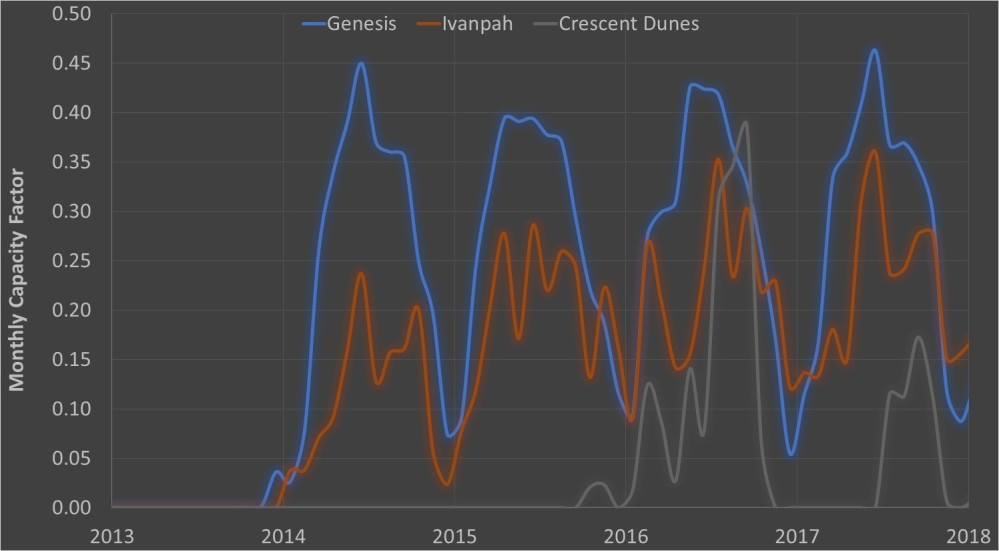The Failure of Solar Tower Thermal Energy Storage
Written by Albert Parker
Concentrated solar power is not delivering on green energy promises.
Behind the hype these futuristic molten-salt power towers are
generating only 13 percent of predicted capacity. But their most
worrying issues concern problems with thermal energy storage.
If we consider the latest (2017)
National Renewable Energy Laboratory Annual Technology Baseline data,
[1] and [2], they say current representative technology for
concentrating solar power is molten-salt power towers with 10 hours
two-tank thermal energy storage. They admit the first (and only) large
molten-salt power tower plant with 10 hours of storage is Crescent
Dunes, 110 MW, commissioned in 2015.
Their concentrated solar power workbook is based on purely
hypothetical solar towers with direct two-tank 10 hours thermal energy
storage supposed to deliver annual capacity factors (ratio of actual
electricity delivered in a year vs. the product of the installed
capacity by the number of hours in a year) largely exceeding the 50%
mark, more precisely 56% in an insulation class 3 location (Las Vegas,
NV) or 59% in an insulation class 5 (Dagget, CA).
These capacity factors of 56% and 59% correspond to an annual
electricity production per unit capacity (power) of 4,906 and 5,168
kWh/kW that are nowhere to be seen even close in plants on Earth.
If we look at the operational Concentrated Solar Power stations of
capacity above even only 50 MW in the entire world, this list includes
34 stations, 31 of them are parabolic trough, a much more consolidated
and reliable concentrated solar power technology, 1 is Fresnel
reflector, and only 2 of them are solar tower.
The 2 power stations are both in the United States, the 377 MW
Ivanpah Solar Electric Generating System and the 110 MW Crescent Dunes
Solar Energy Project. As actual electricity production of these plants
is available from the United States Energy Information Administration
[3], we may certainly check if the numbers by NREL are right.

As a comparison, we also consider the data of a more reliable
concentrated solar power parabolic trough plant similarly recently
built, the 250 MW Genesis, that has no thermal energy storage.
For the 377 MW Ivanpah, the planned electricity production was
1,079,232 MWh per year, corresponding to a capacity factor of 32.68%,
with minimal support by burning natural gas.
For the 110 MW Crescent Dunes, the planned electricity production was
500,000 MWh per year, corresponding to a capacity factor of 51.89%.
For Genesis, the planned electricity production was only 580,000 MWh per year, corresponding to a capacity factor of 26.48%.
Figure 1 (below) presents the monthly capacity factors of Ivanpah,
Crescent Dunes and Genesis. Worth mentioning, the monthly capacity
factors vary according to the season.
To deliver an annual capacity factor of 56% or 59% solar only, the
summer capacity factors should be much larger than that to compensate
the lower spring/fall and more than that winter capacity factors.
Ivanpah has no thermal energy storage, but boost by combustion of
natural gas. So far, it has been able to reach a 21.29% annual capacity
factor only not accounting for the significant natural gas combustion.
As the natural gas can be burned better in a combined cycle gas turbine
plant, the actual annual capacity factor is reduced to 14.42% when
corrected for the consumption of natural gas in a combined cycle gas
turbine plant.
Crescent Dunes is the current representative technology for concentrating solar power by NREL.
The project has delivered so far much less than the projected
electricity production, a 13.21% annual capacity factor in the best
year.
The plant had a major issue in the thermal energy storage that
prevented electricity production for a long time, and is not recovering
yet.
The more reliable Genesis has been able to produce electricity
reaching an annual capacity factor of almost 30% without any boost by
natural gas combustion, a value even better than the expected.
It does not seem appropriate to propose as “current technology” a technology that does not seem mature yet, while downplaying what is already working much better.
The thermal energy storage is not such a well proven and mature
technology. Similarly, but marginally better, the solar tower technology
is much more troublesome than the parabolic trough technology.
While NREL does not update the numbers to match reality, the South
Australian government and the Federal Government of Australia have
recently decided to build (about) same of Crescent Dunes power plant by
same developer in Port Augusta, South Australia [4], [5].

Fig. 1 – Monthly capacity factors for the Ivanpah, Crescent Dunes and
Genesis concentrated solar power plants. Design annual capacity factors
are 32.68% for Ivanpah (but with minimal support from the burning of
natural gas), 51.89% for Crescent Dunes, and 26.48% for Genesis. Ivanpah
has been able to reach a 21.29% annual capacity factor in 2016 only not
accounting for the significant natural gas combustion. Crescent Dunes
has delivered a 13.21% annual capacity factor in 2016. Genesis has been
able to produce electricity reaching an annual capacity factor of almost
30% in 2006.
Read more at qualityassuranceofclimatestudies.wordpress.com
References
[1] National Renewable Energy Laboratory (NREL). 2017 Annual
Technology Baseline. Golden, CO: National Renewable Energy Laboratory. www.nrel.gov/analysis/data_tech_baseline.html
[2] National Renewable Energy Laboratory (NREL). Concentrating Solar
Power. atb.nrel.gov/electricity/2017/index.html?t=sc&s=ov
[3] Energy Information Administration (EIA). Electricity data browser – Plant Level Data.
Available online: www.eia.gov/electricity/data/browser/
[4] ABC News (2017), Solar thermal power plant announced for Port Augusta ‘biggest of its kind in the world’.
www.abc.net.au/news/2017-08-14/solar-thermal-power-plant-announcement-for-port-augusta/8804628
[5] Renewable Economy (2017). Aurora: What you should know about Port Augusta’s solar power-tower.
reneweconomy.com.au/aurora-what-you-should-know-about-port-augustas-solar-power-tower-86715